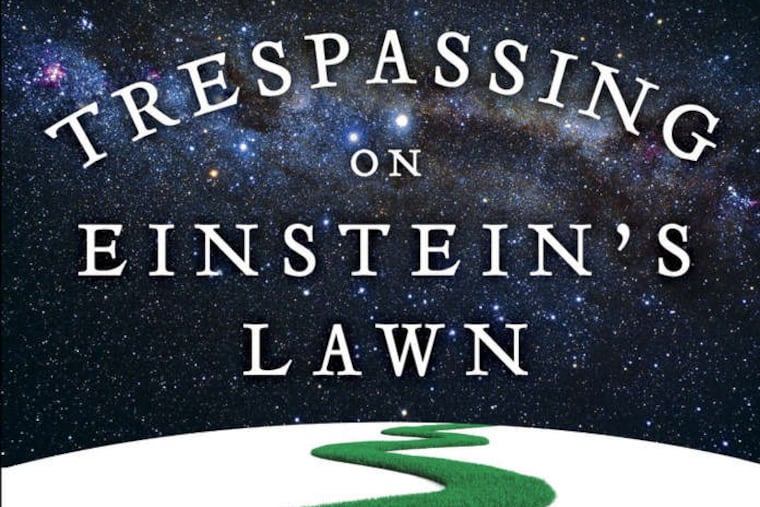Two on the road into nothingness
Albert Einstein specified before his death that his house at 112 Mercer St. in Princeton should not be made into a place of pilgrimage, a tourist stop for genius-worshipers. That doesn't stop acolytes of the crazy-haired father of relativity from passing by on car or foot, perhaps with a secret wish to roll on the grass and somehow soak up the brilliance of the man who conceived of the space-time continuum.

Trespassing on Einstein's Lawn
A Father, a Daughter, the Meaning of Nothing, and the Beginning of Everything
By Amanda Gefter
Bantam. 432 pages. $28 nolead ends
nolead begins
Reviewed by Gary Stix
Albert Einstein specified before his death that his house at 112 Mercer St. in Princeton should not be made into a place of pilgrimage, a tourist stop for genius-worshipers. That doesn't stop acolytes of the crazy-haired father of relativity from passing by on car or foot, perhaps with a secret wish to roll on the grass and somehow soak up the brilliance of the man who conceived of the space-time continuum.
Two Philadelphia suburbanites, Amanda Gefter and her father Warren, restrained any impulse to lie on the lawn when they visited one spring day in 2002. The two self-taught physics aficionados did sit on the sidewalk in front until a car unexpectedly appeared and they picked up and ran.
Trespassing on Einstein's Lawn is not only an account of that trek to Princeton, but also a zany superposition of genres by the younger Gefter. It's at once a coming-of-age chronicle and a father-daughter road trip to the far reaches of this universe and 10500 others. It's also an exploration of the quandaries of a self-confessed science/mathophobe trying to master mind-bendingly difficult concepts from cosmology and theoretical physics as part of a personal quest to discover the underpinnings of physical reality, if, as you will learn, such a thing actually exists.
The father-daughter great adventure begins in the mid-1990s in a Chinese restaurant west of Philadelphia, when Gefter, then 15, pushes a cashew with a chopstick across her plate. Her father, a renowned radiologist at the University of Pennsylvania experiencing a touch of midlife angst, suddenly asks: "How would you define nothing?" That query leads immediately to an intense back-and-forth about nada as an "infinite, unbounded homogeneous state," achieved only by taking a blender to the world and turning everything into viscous nothingness.
"We should figure it out," her father quips, as he motions for the check. Somewhat to her own surprise, the otherwise bored teen rises to the challenge. The two go on an autodidactic frenzy to learn as much as they can. This leads to a list of cosmic "essentials" on an IHOP napkin.
List in hand, the rest of Einstein's Lawn is taken up with visits to interview world-beating physicists, who receive the third degree about whether the presumptions on the List are, in fact, correct. Items are gradually crossed off as the duo edge toward their own ultimate answer to the question of whether the universe/s is/are just one big cosmic smoothie.
(Full disclosure: Scientific American, where I work, was recruited at one point to procure a writing assignment to help Gefter execute her grand plan.) During these journeys, she runs into Leonard Susskind, the former plumber from the Bronx, now a preeminent luminary in the realm of string theory and multiverses. There is Ed Witten, "the smartest man alive," who nonetheless is spied at one conference trying to push a revolving door in the wrong direction. Stephen Hawking even makes a cameo in an e-mail. A constant presence is John Wheeler, the now-deceased Princeton physics professor who worked with Einstein and Niels Bohr, and collaborated on the Manhattan Project and development of the hydrogen bomb.
Gefter makes a pervasive theme of Wheeler's idea, rooted in quantum mechanics, that nothing, not even time, exists until someone tries to observe it and other simulacra of the physical world.
Where science writing about the origins and ultimate fate of the universe is usually spoon-fed to the reader, in a linear, historical narrative, Gefter discards any such semblance. As soon as she meets a new mind-bending concept for the first time, so does the reader. By the first few pages, you're already immersed in quantum gravity and singularities. This can at times make for heavy going, and the explanatory glossary at the back, aimed at being a kind of space-time GPS, can sometimes verge on parody. The term AdS/CFT, for example, is defined as "an anti-de Sitter space with five large and five tiny dimensions . . . exactly equivalent to a conformal field theory (without gravity)."
The goal of all this is to frame the narrative as a personal journey, not a physics primer. Gefter revels in mocking herself as the starry-eyed fan. Exuberant at finding a new paper by Hawking online, she describes the experience as "the one thing that can make any girl giggle and blush with delight."
The book largely ignores the pointed criticism that cosmology and theoretical physics have reached a dead end because there will never be particle accelerators powerful enough to test these theories. Gefter is too busy zigging and zagging between the overwhelmingly dense technical arguments of professional physicists and the plebeian mind-set of being just another tattooed Johnny Depp fan.
At every step, Einstein's Lawn transcends the traditional categorizations publishers try to confer on the books they market. That means accessing Wikipedia might be a better way to gain an overview of the conceptual complexities Gefter describes. Einstein's Lawn will never be an Idiot's Guide to the Cosmos. But neither was that Gefter's intent in telling her story.
AUTHOR APPEARANCE
Amanda Gefter: "Trespassing on Einstein's Lawn"
6 p.m. Tuesday at the Penn Bookstore, 3601 Walnut St.
Information: 215-898-7595 or http://upenn.bncollege.comEndText